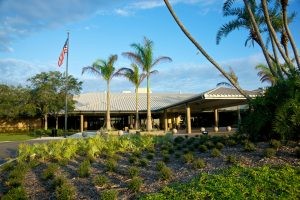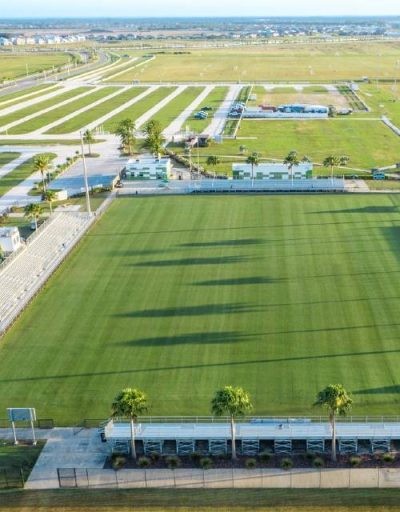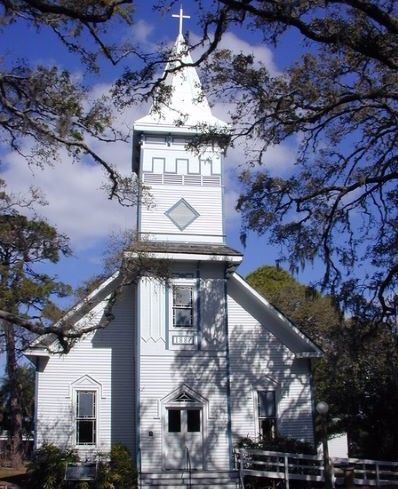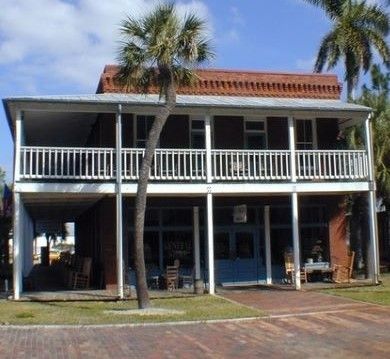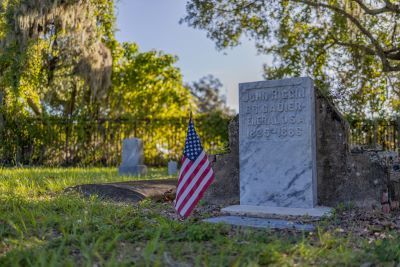Behind the Scenes at Manatee Village Historical Park
Behind the Scenes at Manatee Village Historical Park
Engineer lets off some steam, And backs the throttle down.Children run outside the house to wave.Whistle blast cuts clear and low,As they rattle through the town.A moment from another time,All too soon was gone.– Ode to Old CabbageheadThe 1913 steam engine known as Old Cabbagehead (whose rather bizarre sobriquet comes from the rounded top of its smokestack) is perhaps the most famous and beloved display inside Manatee Village Historical Park. Clearly visible from Manatee Avenue, the old engine grabs a lot of attention from passersby – especially children.“A lot of people drive by, see Old Cabbagehead and don’t even realize there’s more past that,” explains Rachel DesRosier, Manatee Village’s Marketing & Events Coordinator. “They just think, ‘Oh, cool, here’s a historical train.’ There so much more to see.”The purpose of Manatee Village is to preserve and share the heritage of Manatee County’s founding, a period that runs from 1840 through 1918. How they accomplish it is through a collection of historical buildings (some originals, some replicas), exhibits and special events — including lectures, book signings, festivals, workshops, and demonstrations.
It takes a village to make a village
Stepping inside the 1887 Church – an impeccable sanctuary filled with rows of pews as rigid and wooden as the floors – you can almost imagine yourself as one of the regular village folk entering for worship.
What you can’t imagine is that it was nearly torn down in the name of progress were it not for a very determined group of women.
Upon learning, in 1974, that their beloved church and a smaller building owned by the congregation (the original Manatee County Courthouse) were to be destroyed, they vowed to do whatever it would take to save the two historic buildings. And the idea for the Manatee Village Historical Park was born.
The women called themselves the HOME (Heritage of Manatee’s Environment) Committee and went to work. They quickly revived the defunct Manatee County Historical Commission, petitioned land for the park and by 1975 both structures were safely standing at their new home.
“According to the lore, it was on a nice chilly night in December,” Rachel recounts. “They didn’t want to do it during the day because of traffic.”
Moving the buildings themselves was no problem. But it wasn’t without some surprises.
“I’ve heard stories about people freaking out,” says Rachel, “Because they didn’t know it was going to happen and seeing this church cross the street.”
What had started out as two old buildings set for demolition became a rallying cause for the local community. The restoration effort became part of Manatee County’s celebration of the United States bicentennial and funding rolled in.
On July 4, 1976, the park officially opened to the public. Since then, it’s grown to include fourteen structures that represent a sliver of pioneer life in Manatee County, including Old Cabbagehead.
“So over time, we’ve got all these other buildings. And we’ve created this cool village that’s as close as you can get to what it would have been in the Village of Manatee,” Rachel says.
Get to know the first families and their way of life
But it’s not just the structures that make this place special.
It’s the stories of the people behind the places: The Gates, The Wiggins, The Stephens and so many others. Inside these buildings, their stories of a bygone era live on.
Spoiler alert: it wasn’t easy.
“People would definitely have to be tough,” Rachel describes. “There weren’t a bunch of places that people could go to. There wasn’t much of a medical system. Or really even a church. Before the 1887 Church, people would gather at a local hotel or the courthouse. So there weren’t a lot of resources that they could depend on.”
She continues, “They were dealing with the weather. They were dealing with not having very much food and having to grow things. So, that was one of the primary things that people would focus on.”
And then of course there was the wildlife. Rachel recalls one story about the Gates, the founding family of the Village of Manatee in 1842. “Josiah Gates’ wife, Mary, was in the kitchen,” she tells, “and a bear just wanders in.”
Luckily, her brother-in-law was able to shoot it before she was hurt.
“That was like an everyday risk. You’re not around other people. You’re around wildlife,” Rachel adds. “People were gambling when moving here. They had to work together to survive.”
The importance of preserving history
The goal of Manatee Village is to tell real stories, preserve real places. Says Rachel, “We’re very lucky to have these structures. What makes it so important is that it’s real. These are real stories.”
The trouble with history is, because our modern lives are so in the now, it can be hard to make the connection. The stories make it feel more real. “It feels like a long time. It’s really not that long ago,” Rachel notes, “I’ve even had people come from other states and find out they have a relative they can trace back to Manatee Burying Ground.”
And through history, we can learn a lot about ourselves.
Rachel explains, “Also, just thinking about how we survive today. If I was living back then, what would be similar? What would be different? It really connects to our emotions, our humanity and our connections to other people. And our history of having to work together.”
“These are things in our culture and human history in general that just will always be. The longer people live, the more history we’re going to have.”
What to do, see and where to learn more
There are more than a dozen structures to explore at Manatee Village. Here is a small sample of some of the more well-known structures. But many others — such as the Fogarty Boatworks, The Blacksmith Shop, the Smokehouse and Mill, and the Old Schoolhouse — have plenty of stories to tell.
Admission to the park is free, but donations are appreciated.
Where to begin – Wiggins General Store
There’s no specific path for touring Manatee Village. You can explore at your own pace. But every visit should begin at Wiggins General Store – the heart and soul of any pioneer village and the only building on-site that occupies its original footprint.
In the old days, people came from miles around to shop at King Wiggins’ store. In fact, the upstairs was converted into a boarding house where folks could rest up for the long journey home.
Today, you can peruse the most sought-after sundries of the day, pick-up maps and educational materials about the village, and search for souvenirs in the Whistle Stop Gift Shop.
According to Rachel, one of the biggest draws is a new addition that no general store can go without: an authentic cash register from the period perfectly restored.
Where to cool off – The Stephens House
Also known as the Settler’s House, it’s named after the Will Stephens family, who constructed it in 1912 on a farm near the community of Ona in Hardee County, Florida. One of the things that makes this property unique is how much we know about the family who owned it.
It’s a typical pioneer farmhouse built in what’s come to be known as the “Cracker Gothic” architectural design, which was well suited for Florida’s hot, humid days, long before the days of A/C and smart therms.
It’s not just a favorite attraction for visitors, it’s one of Rachel’s favorites too. “I love the architecture,” she explains. “You walk in and it still feels like you’re outside because it’s got an open hallway to keep the house cool and I’ve always loved that.”
“A lot of key family members today still have documentation and wrote books about what they’d been told,” Rachel explains. “And that’s kind of hard to find.”
“I remember reading stories about the family dog and about coming across wild animals and how one of the daughters got sick and died of appendicitis,” she adds. “So their family has been very helpful in filling in the blanks.”
Where to be scared – The 1850 Manatee Burying Grounds
One of Manatee Village’s most famous sites isn’t a building at all, but a location: the 1850 Manatee Burying Grounds. In use between 1850 through 1892, it’s the oldest public cemetery in Manatee County, with a few family burials occurring up until the 1960s.
It’s the final resting place for some of the area’s original settlers, including Josiah Gates, the first to settle the area. Among other names dipped in history is Curtis Henderson Stanton, whose family operated steamships on the Manatee River and whose brother died in 1912 while on the first and only voyage of the doomed Titanic.
The Burying Grounds are open during museum hours. Ask the staff in the Wiggins General Store for the key and take a self-tour if you dare. But if you can’t come in person, you can still take a tour of the Burying Grounds online through the month of October, when Manatee Village hosts “Tombstone Tour,” an online event that walks you through the history of the cemetery, the meaning of tombstone symbols and the stories of those who were buried there. The event is free and registration is open through November 1, 2020.
Where to take the kids – Junior Junction
In the old days, kids would clamber all over Old Cabbagehead. These days, not so much. But this train-themed playground provides a place for visitors age 2-12 years to let off some steam during their time at the Park.
Picnic tables and live oak trees provide the perfect spot where families can relax.



